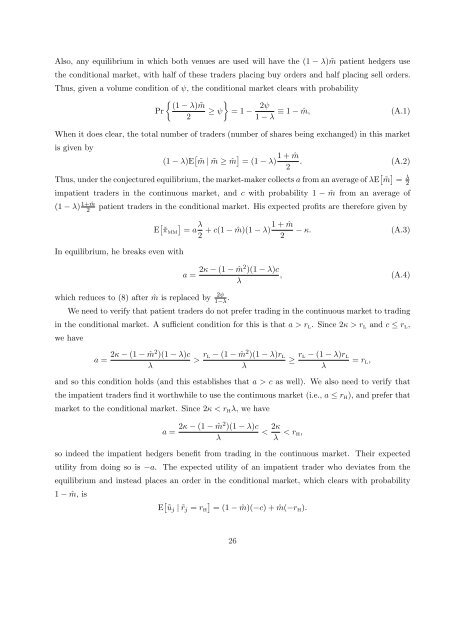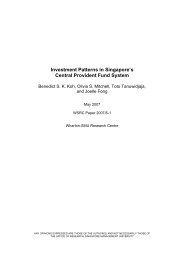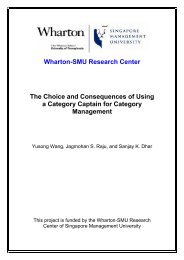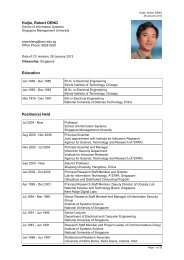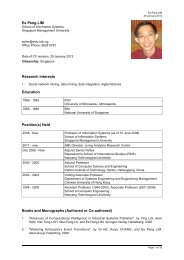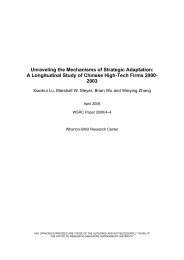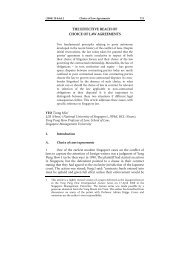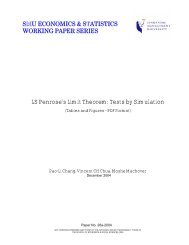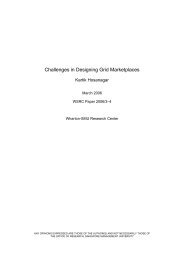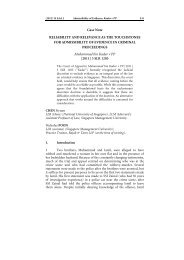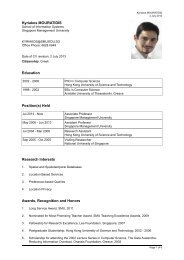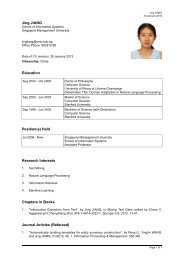The Benefits of Volume-Conditional Order-Crossing - Singapore ...
The Benefits of Volume-Conditional Order-Crossing - Singapore ...
The Benefits of Volume-Conditional Order-Crossing - Singapore ...
You also want an ePaper? Increase the reach of your titles
YUMPU automatically turns print PDFs into web optimized ePapers that Google loves.
Also, any equilibrium in which both venues are used will have the (1 − λ) ˜m patient hedgers use<br />
the conditional market, with half <strong>of</strong> these traders placing buy orders and half placing sell orders.<br />
Thus, given a volume condition <strong>of</strong> ψ, the conditional market clears with probability<br />
<br />
(1 − λ) ˜m<br />
Pr<br />
≥ ψ = 1 −<br />
2<br />
2ψ<br />
≡ 1 − ˆm, (A.1)<br />
1 − λ<br />
When it does clear, the total number <strong>of</strong> traders (number <strong>of</strong> shares being exchanged) in this market<br />
is given by<br />
(1 − λ)E ˜m | ˜m ≥ ˆm = (1 − λ)<br />
1 + ˆm<br />
. (A.2)<br />
2<br />
Thus, under the conjectured equilibrium, the market-maker collects a from an average <strong>of</strong> λE ˜m = λ<br />
2<br />
impatient traders in the continuous market, and c with probability 1 − ˆm from an average <strong>of</strong><br />
1+ ˆm (1 − λ) 2<br />
patient traders in the conditional market. His expected pr<strong>of</strong>its are therefore given by<br />
E λ<br />
˜π MM = a<br />
2<br />
In equilibrium, he breaks even with<br />
+ c(1 − ˆm)(1 − λ)1 + ˆm<br />
2<br />
− κ. (A.3)<br />
a = 2κ − (1 − ˆm2 )(1 − λ)c<br />
, (A.4)<br />
λ<br />
which reduces to (8) after ˆm is replaced by 2ψ<br />
1−λ .<br />
We need to verify that patient traders do not prefer trading in the continuous market to trading<br />
in the conditional market. A sufficient condition for this is that a > r L. Since 2κ > r L and c ≤ r L,<br />
we have<br />
a = 2κ − (1 − ˆm2 )(1 − λ)c<br />
λ<br />
> r L − (1 − ˆm 2 )(1 − λ)r L<br />
λ<br />
≥ r L − (1 − λ)r L<br />
λ<br />
= r L,<br />
and so this condition holds (and this establishes that a > c as well). We also need to verify that<br />
the impatient traders find it worthwhile to use the continuous market (i.e., a ≤ r H), and prefer that<br />
market to the conditional market. Since 2κ < r Hλ, we have<br />
a = 2κ − (1 − ˆm2 )(1 − λ)c<br />
λ<br />
< 2κ<br />
λ < r H,<br />
so indeed the impatient hedgers benefit from trading in the continuous market. <strong>The</strong>ir expected<br />
utility from doing so is −a. <strong>The</strong> expected utility <strong>of</strong> an impatient trader who deviates from the<br />
equilibrium and instead places an order in the conditional market, which clears with probability<br />
1 − ˆm, is<br />
E ũj | ˜rj = r H<br />
= (1 − ˆm)(−c) + ˆm(−rH).<br />
26


